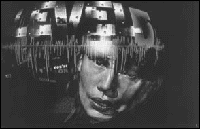|
|
|
監督・撮影:クリス・マルケル
Director, Photography : Chris Marker |
クリス・マルケル 1921年生まれ。戦時中は反独レジスタンス活動に身を投ずる。1950年前後からドキュメンタリー映画に関わり、アラン・レネとの共同監督『彫像もまた死す』(1953)や、『北京の日曜日』(1956)などで頭角を現す。全編スチール写真で構成したSF短編『ラ・ジュテ』(1962−64)はカルト的傑作に。旅する映画作家として知られ、日本を題材にした作品も『不思議なクミコ』(1964)『サン・ソレイユ』(1982)『AK』(1985)、そして本作と多数。また近年では、『アレクサンドルの墓〜最後のボルシェヴィキ』などビデオ作品も多数あり、本作も撮影は主にビデオである。コンピューター・メディアやテレビゲームにも強い関心があり、映画百年を記念するマルチメディア・インスタレーション『Silent Movie』は 1995年以来米国各地を巡回中。最新作は人間と世界それぞれの“記憶”をテーマにしたCD-ROM 『Immemory』(1997)で、パリ、ポンピドゥー・センターで展示されている。 Born in 1921. Faught in anti-German Resistance during World War II. Started to work on documentary film around 1950, and was quickly acclaimed with films such as Sculptures also Die ( "Les statues meurent aussi, " 1953), co-directed with Alain Resnais; A Sunday in Peking ( "Un Dimanche en P 嗣ing, " 1956); Letters from Siberia ( "Lettres de Sib 屍ie, " 1958). His SF short La Jet 仔 (1962- 64), entirely composed from still photographs, is admired as a cult masterpiece. As a filmmaker on journey, he has choses Japan as his subject in Le Myst屍e Koumiko (1964), Sans Soleil (1982), AK (1985), and LEVEL FIVE . Marker has also produced many video works including The Last Bolshevik (1993), screened at the 1995 Yamagata Festival. LEVEL FIVE was also shot on video. Also known as a computer media artist and a fanatic of video games, his multi-media installation Silent Movie, celebrating the centenary of cinema, has been circulating around the US since 1995. His latest work, the CD-Rom Immemory, exploring humanity's and the world's collective memories, is currently on exhibition at Centre Georges Pompidou in Paris. |
 |
|
|
監督のことば 第二次世界大戦についてのCD−ROMが最近よく話題になる。その中で沖縄をひいてみよう。「10万人の死者、多数の民間人を含む…」これは二重の誤りだ。日本側の軍の死者は確かに10万だった。だが民間人は沖縄人たち、別個の民族で、自分たちの歴史と自分たちの文化を持ち、最初は中国、ついで日本に併合された人々。沖縄人の死者は15万人、その人口の3分の1と推定されている―取るに足らない数?!この死者の大部分が集団自決だった。降伏してはならないと洗脳されていたのだ。これは他に例をみない、第二次大戦のなかでもっとも狂気にみち、無残な実話だが、歴史には素通りされ、我々の集合的意識からは抹消されている、だから私は再び光を当てようと思ったのだ。 テレビの存在は大きな違いになった。『レベル5』の沖縄の部分は目撃証言を基にしている。これをいわゆる「ドキュメンタリー」の中に想像して欲しい―普通にテレビを見る―日の中へ、ボスニアのある個人の悲劇や、ホロコーストの生き残りの物語と一緒に放り込まれたとして。平均的なテレビ視聴者はこのような苦しみの証言をどれだけ連続して受け止めながら、なおかつそれぞれに固有の感覚を見失わないでいられるだろうか?別の何かが必要だった。 答えはテレビゲーム、コンピューター・グラフィックス、それに女―私のお気に入りの白昼夢だ。私は自分の手の内にあるものだけを使う。 日本の撮影部分を除けば、この映画はデュエットとして、二人だけで、縦横6×10フィートの部屋の中だけで、撮影隊も、技術的補佐もなしで作った。 我が同志アストリュックの主張したペンとしての映画カメラは、彼の時代には比喩でしかなかった。だが我々はその手段を持っている(それもまったく新しいものなのだ)―親密で、孤独な映画作りのために。自分自身と向き合う映画を作るためのプロセス。 (『レヴェル5』プレス、ドロレス・ウォルフィッシュとのインタビューより構成) |
Director's Statement There's been a great deal of talk, recently, about a CD-ROM on World-War II. Look up Okinawa. It says, "There were about 100,000 casualties, including numerous civilians.... ", which is doubly wrong. Japanese military casualties certainly totalled about 100,000. But the civilians were Okinawans, a separate community, with its own history and its own culture, annexed first by China and then by Japan. The number of Okinawan dead is estimated at 150.000, one third of its population --a snip. And many of those were mass suicides, because people had been brainwashed into not surrendering. The case is unique, one of the maddest and deadliest episodes in the Second World War, bypassed by history, erased from our collective consciousness, and that is why I wanted to bring it to light. Television has made a big difference. The entire Okinawa chapter in Level Five is based in eye-witness account. Picture that in some kind of documentary, slotted into the average viewing day, between some personal tragedy in Bosnia and a Holocaust survivor's story. How many such successive tales of sufferings can the average television viewer take in without losing a sense of the uniqueness of each? There had to be another way. The answer was a video game, computer graphic, and a lady--my favorite hallucinations. I use what I've got. Except for the Japanese footage, the film is a duet, manufactured by two people in a room six foot by ten, with no crew, no technical assistance. My comrade Astruc's notion of camera as a pen was only a metaphor
in his day. But we possess the wherewithal --and this is something
new--for intimate, solitary filmmaking. The process of making
films in communion with oneself. - From the interview with Dolores Walfisch in the press LEVEL 5 |